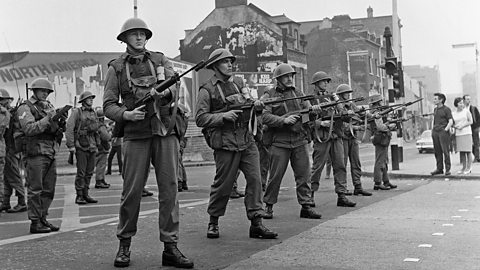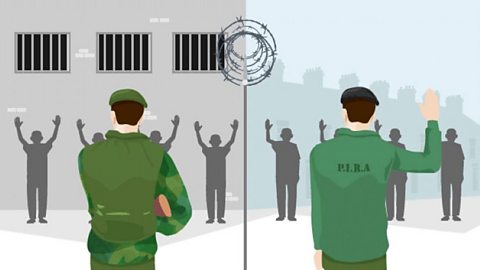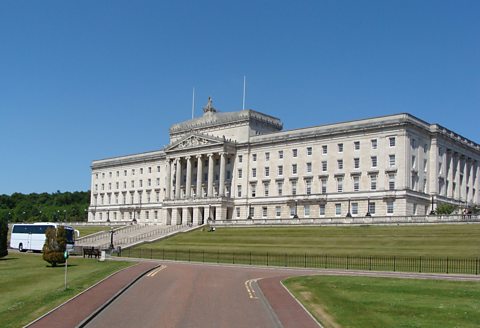Introduction
Prime Minister Terence °ҝвҖҷNұрҫұұфұфвҖҷs policies might have been introduced for the right reasons, but by the late 1960s they had created divisions amongst unionistA person who believes the union between Britain and Northern Ireland should continue. who feared that too much was being given away to nationalistPeople who believe their country should be independent from other nations. For example, Irish nationalists, who want Ireland to be fully independent of Britain..
At the same time, the hopes raised within nationalism by the changes °ҝвҖҷNұрҫұұфұф promised were never going to be achieved.
As a result, nationalist frustration grew.
Origins and aims
An overview of the Northern Ireland Civil Rights Association
The Northern Ireland civil rights Rights everyone is entitled to regardless of the colour of their skin, their beliefs, sexuality, sex or other personal characteristics. These rights could include - amongst other things - the right to vote, the right to free speech or the right to a good education. Association (NICRA) was formed in early 1967, taking much of its inspiration from the ongoing US civil rights campaign.
At the same time, there were other sources of encouragement in the period following NICRAвҖҷs establishment, notably the student demonstrations that took place in France during 1968.
What particularly appealed to NICRAвҖҷs leaders was the American groups' use of non-violent methods ofcivil disobedienceA form of peaceful protest in which someone refuses to obey certain laws because they believe they are unjust. as part of its campaign to achieve equality for black people.
Most importantly, by 1967, a series of marches and protests had led the CongressThe legislative body of the US government, made up of the Senate and the House of Representatives. to pass laws outlawing public discriminationTreating people differently on the basis of a particular characteristic, such as race, religion or sex. and guaranteeing voting rights.
These successes were widely reported in Europe.
Question
What were NICRAвҖҷs aims?
NICRA claimed to be open to both Protestants and Catholics, and also stated that it was not trying to create a united Ireland.
Its aims were as follows:
- Achieve one-man one vote (OMOV) for local council elections. If this was introduced, anyone over the age of 18 would be allowed to vote. OMOV would also end the practice of giving multiple votes to business owners.
- Ensure that local councils allocated their council housesHouses built and owned by local authorities, which act as landlords for the people living in them. fairly. At this time, only those who paid ratesA payment made by householders to their local council. were allowed to vote in local council elections. If councils did not give Catholics houses then they could not vote.
- Stop the practice of gerrymanderingThe practice of drawing electoral boundaries in a way that benefits one particular group at the expense of another..
- Ensure that religion was not used as a factor when allocating government jobs.
- End the use of the Special Powers ActA law - first passed by the Northern Ireland Government in 1922 вҖ“ which allowed it to arrest and detain terrorist suspects without trial..
- Disband the B SpecialsFormerly part of the reserve police force in Northern Ireland. Disbanded in 1969..
- Introduce a system that allowed people to report local council violations in any of the above areas.
Test your knowledge
Reaction to NICRA
Support
NICRA received support from different sections of the Northern Ireland public.
These included:
- A new generation of Catholics who had been able to attend secondary school free of charge as a result of the introduction of the eleven-plus (11+) examinationAn examination which was undertaken by Primary 7 pupils and which governed admission to different types of secondary schools. It was introduced in Northern Ireland in 1947. The last eleven-plus was held in 2008. in 1947.
- Those nationalistPeople who believe their country should be independent from other nations. For example, Irish nationalists, who want Ireland to be fully independent of Britain. who believed that the local Nationalist Party (led by Eddie McAteer) had lost touch with the needs of its people.
- Moderate unionistA person who believes the union between Britain and Northern Ireland should continue. who believed that Northern IrelandвҖҷs Catholics were being unfairly treated. These unionists also believed that if NICRAвҖҷs aims were achieved, there would be no reason for Catholics to want to be part of a united Ireland.
- Other groups and individuals including academicSomeone whose work is done in schools, colleges, and universities and which involves studying and reasoning. and trade unionistA member of a trade union, which is an organisation of workers formed to protect the rights of its members. A trade union might argue for better wages or working conditions..
Opposition
Opposition to NICRA came from a large section of the unionistA person who believes the union between Britain and Northern Ireland should continue. population.
They feared that:
- NICRA was nothing more than the Irish Republican Army (IRA)A republican paramilitary group which was determined to create an Irish Republic as proclaimed in the 1916 Easter Rising.under a different name.
- NICRA was not interested in equality for everyone in Northern Ireland. Instead it was only looking out for the needs of Catholics. They were also afraid that NICRAвҖҷs campaign could weaken Protestant control of Northern Ireland, thus leading to a united Ireland.
First march
The story of the protest at Caledon
On 24th August 1968, NICRAвҖҷs held its first march:
- The march began in Coalisland and ended in Dungannon.
- It was organised to protest at Dungannon Council's decision to allocate one of its council housesHouses built and owned by local authorities, which act as landlords for the people living in them. in the village of Caledon to a 19-year-old Protestant woman rather than a large Catholic family.
Violence in Londonderry
The Coalisland-Dungannon march passed off peacefully; however things were not quite so peaceful at NICRAвҖҷs second march, held in Derry/Londonderry on 5th October 1968.
Again, the march was organised to draw attention to what NICRA saw as discriminationTreating people differently on the basis of a particular characteristic, such as race, religion or sex. - in this case Londonderry CorporationThe local council in Derry housing policy.
Some of DerryвҖҷs Protestant population were very unhappy with NICRAвҖҷs plans and so the cityвҖҷs Apprentice BoysA loyalist historical club set up to remember the group of apprentices who closed the gates of Derry/Londonderry against the armies of King James II in 1689. announced plans to hold their own demonstration at the same time.
Fearing an outbreak of violence the Stormont Government banned both marches - however NICRA let it be known that it would ignore this ban.
NICRAвҖҷs march started on Duke Street in DerryвҖҷs Waterside area.
As it moved towards the Craigavon Bridge - accompanied by four WestminsterThe London location of the British government. MPs and an RTERaidiГі TeilifГӯs Гүireann, the Republic of Ireland's national TV and radio broadcaster. camera crew - the protestors were faced by lines of police officers.
Some of the police were heavy-handed in their efforts to stop the march - their tactics were captured by the RTE television crew and the resulting images were widely seen at home and abroad.
Further NICRA marches made the situation even worse.
Quite often violence resulted and there were several reasons for this:
- NICRA continued with marches even after they had been banned.
- Some marches went through Protestant areas and this was seen as provocativeIntended to cause a strong reaction. .
- Counter-demonstrations organised by unionistA person who believes the union between Britain and Northern Ireland should continue. sometimes came into contact with NICRAвҖҷs marches.
Reform
As a result of this unrest, Terence °ҝвҖҷNұрҫұұфұф, Brian Faulkner and William Craig were summoned to Westminster on 4 November to meet the British Labour Prime Minister, Harold Wilson.
The outcome was the announcement on 22nd November 1968 of a Five Point Reform Programme.
- A points system to ensure fairer allocation of council houses.
- Londonderry CorporationThe local council in Derry was to be replaced by a Development Commission.
- The removal of some parts of the Special Powers ActA law - first passed by the Northern Ireland Government in 1922 вҖ“ which allowed it to arrest and detain terrorist suspects without trial..
- The removal of additional votes for owners of businesses (along with other reforms to the operation of local government).
- The establishment of an ombudsman An official who deals with complaints from the public. to examine complaints.
- It was stated that all of these reforms would be put in place by late 1971.
'Ulster at the crossroads'
Terence O'Neill: "Ulster stands at the crossroads"
Despite the announcement of the Reform Programme, protests and counter-protests continued.
°ҝвҖҷNұрҫұұфұф, therefore, went on television in an attempt to bring home to people the dangerous situation that Northern Ireland now found itself facing.
In what became known as the вҖҳUlster at the CrossroadsвҖҷ speech, the Prime Minister made a particular appeal to NICRAвҖҷs leaders to help avoid 'chaos'.
In the short term, °ҝвҖҷNұрҫұұфұфвҖҷs television broadcast seemed to work as NICRA marches were called off.
At the same time, however, the Prime Minister found himself facing opposition from inside and outside his own Party:
- William Craig, the Minister for Home Affairs, criticised °ҝвҖҷNұрҫұұфұфвҖҷs television appearance and accused his leader of doing what the London government told him to do. °ҝвҖҷNұрҫұұфұф responded by sacking Craig, but this did not deter opposition.
- Many unionistA person who believes the union between Britain and Northern Ireland should continue. opposed the Five Point Reform Programme. They believed that °ҝвҖҷNұрҫұұфұф had only made the concessions due to the threat of violence and felt that the reforms would weaken unionist control of Northern Ireland.
PeopleвҖҷs Democracy
NICRA might have agreed to stop marching in response to °ҝвҖҷNұрҫұұфұфвҖҷs television appeal; however others were not so willing to stop protesting against what they saw as injustice.
One such group was the recently-formed PeopleвҖҷs Democracy, established by university students (among others) in the aftermath of the police attack on the NICRA march in Derry/Londonderry on 5th October 1968.
Its leading figures were Michael Farrell and Bernadette Devlin (who was elected Westminster MP for Mid Ulster in April 1969).
Its aims were:
- One man, one vote (OMOV).
- Fair boundaries
- Houses on need
- Jobs on merit
- Free speech
- Repeal of the Special Powers ActA law - first passed by the Northern Ireland Government in 1922 вҖ“ which allowed it to arrest and detain terrorist suspects without trial.
Unhappy with what it saw as the limited nature of the Five-Point Reform Programme, PeopleвҖҷs Democracy decided to hold a march between Belfast and Derry/Londonderry.
This was a direct echo of the US Civil Rights MovementвҖҷs 1965 marches from Selma to Montgomery.
The march was condemned by NICRA and nationalistPeople who believe their country should be independent from other nations. For example, Irish nationalists, who want Ireland to be fully independent of Britain. leaders, fearing its impact on an already tense situation.
These condemnations were ignored and the march began on 1st January 1969.
People's Democracy march, January 1969
As the organisers had planned to go through a number of Protestant areas, the police enforced a number of changes to the route, to avoid confrontations.
Despite this, the protestors faced a number of attacks; the worst of these took place at Burntollet Bridge, on the outskirts of Derry, on 4th January 1969.
Eyewitness evidence suggests that the police stood by and allowed the attack to continue.
Tensions increased as reports of the ambush emerged; these tensions increased further when later on the same day some police ran riot through nationalistPeople who believe their country should be independent from other nations. For example, Irish nationalists, who want Ireland to be fully independent of Britain. areas of Derry.
Reactions to Burntollet
In response to events in Derry/Londonderry, NICRA began to march again.
Following yet more violence at a NICRA march in Newry, °ҝвҖҷNұрҫұұфұф announced that he was setting up a commissionA group of people given the task of investigating or solving something by the government.led by Lord Cameron which would investigate the вҖҳviolence and civil disturbance in Northern Ireland on and since 5th October 1968'.
However, °ҝвҖҷNұрҫұұфұфвҖҷs actions revealed the depths of division within his own government.
In response to this announcement:
- Brian Faulkner (Minister for Commerce) and William Morgan (Minister for Health) resigned from the cabinetThe name given to the core group of politicians who carry out the major roles within the ruling government of a country.. Faulkner argued that °ҝвҖҷNұрҫұұфұф was too weak to control the situation.
- It soon became clear that FaulknerвҖҷs views were gaining support within the unionistA person who believes the union between Britain and Northern Ireland should continue. Party. In late January 1969, 12 MPs met and demanded that °ҝвҖҷNұрҫұұфұф resign both as party leader and Prime Minister.
°ҝвҖҷNұрҫұұфұф responded by calling a General Election.
His aim was to show that the people of Northern Ireland supported his policies.
The вҖҳCrossroads ElectionвҖҷ
ҙуПуҙ«ГҪ coverage of the 1969 election
What °ҝвҖҷNұрҫұұфұф called the вҖҳCrossroads ElectionвҖҷ took place on 24th February 1969.
Despite the Prime MinisterвҖҷs best efforts, the results were not what he hoped for:
- The Ulster unionistA person who believes the union between Britain and Northern Ireland should continue. Party found its levels of support reduced as its share of the vote decreased by over ten per cent.
- Not all of the MPs elected for the Unionist Party supported °ҝвҖҷNұрҫұұфұфвҖҷs policies.
- °ҝвҖҷNұрҫұұфұф did not get the votes from Catholic voters that he had hoped to get.
- °ҝвҖҷNұрҫұұфұф nearly lost his own seat to Ian Paisley.
- In spite of the poor election results, °ҝвҖҷNұрҫұұфұф remained on as Northern IrelandвҖҷs Prime Minister.
However, unable to end worsening violence and unable to heal the divisions within his own Party, O'Neill resigned on 28th April 1969.
The final nail in his coffin was a series of bombings, which at the time appeared to be the work of the Irish Republican Army (IRA)A republican paramilitary group which was determined to create an Irish Republic as proclaimed in the 1916 Easter Rising. but which were actually carried out by loyalists in an attempt to force °ҝвҖҷNұрҫұұфұф to go.
Loyalist bombings which were wrongly believed to be the work of the IRA
A new Prime Minister
Following °ҝвҖҷNұрҫұұфұфвҖҷs resignation, the Ulster unionistA person who believes the union between Britain and Northern Ireland should continue. Party held its first ever election for its new leader.
The winner was Major James Chichester Clark, who defeated Brian Faulkner by just one vote; the winning vote was cast by Terence °ҝвҖҷNұрҫұұфұф вҖ“ Chichester-ClarkвҖҷs cousin.
Just a week before, Chichester Clark had resigned from °ҝвҖҷNұрҫұұфұфвҖҷs cabinet over the Prime MinisterвҖҷs announcement that the next local government elections would use one-man-one-vote.
At the time of his resignation, he'd claimed that the time was not right for this reform.
However, following his election the new Prime Minister stated that he would continue with the reforms that °ҝвҖҷNұрҫұұфұф had begun.
Archive content from ҙуПуҙ«ГҪ: Ten Chapters of the Northern Ireland Troubles ()
WATCH: The campaign for civil rights - CCEA
Test your knowledge
More on Changing relations: Northern Ireland and its neighbours, 1965-98
Find out more by working through a topic
- count3 of 11

- count5 of 11

- count6 of 11
